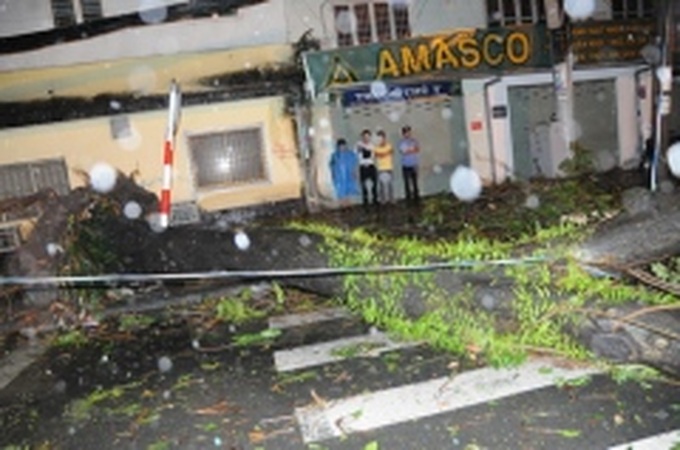 |
| A tree on Mac Dinh Chi - Tran Cao Van crossroad collapsed after the storm hit Ho Chi Minh City last night. |
Active measures had been made before the storm’s landing and were much better than those in preparation for the storm that hit the city in 2006, said Nguyen Van Dua, deputy secretary of the city Party Committee.
Good coordination had been made between soldiers, rescuers, youth volunteers, local authorities and residents in coastal Can Gio District, where the storm first hit before entering the inner districts, he said.
As a result, most residents on Thanh An Island had been moved to safe places one day before the storm landed. Fishing boats had been taken to safe shelters while residents had consolidated their houses.
Tourists in Can Gio had been advised to leave the town as soon as possible before the storm’s landing, and by 2:30 yesterday most of them had returned to HCMC’s downtown.
For safety reasons, city authorities had suspended the Binh Khanh Ferry’s operation from District 7 to Can Gio while maintaining its transportation of passengers from Can Gio to the city.
The storm hit Can Gio at 4 pm yesterday, packing winds of more than 39 kph, and lingered there for about one hour. It knocked down 4 houses, blew roofs off another 16 houses, caused 11 boats to sink, and uprooted 19 trees. Luckily, no casualties were reported.
In the inner districts, strong winds and heavy rains collapsed many trees and submerged numerous streets, including Huynh Tan Phat, Hoa Binh, Au Co, Bau Cat, and Dong Den, with rainfall measuring 102 mm.
A 10 meter-tall tree on Dinh Tien Hoang was uprooted and fell onto an electric transmission line, causing a power outage for a couple of hours. Another tree on Dong Du Street was knocked down onto a moving taxi cab, but caused no casualties.
Many other trees fell on other streets, blocking traffic and uprooting electrical poles.
By 7 pm yesterday 31 trees, including very old ones, had fallen during the storm, the HCMC Tree and Park Company reported. More than 100 staff members have been sent out to handle the fallen trees. By 9 pm, many more trees had been knocked down by violent winds on Tran Hung Dao, Dong Du, Nguyen Thi Nghia, Hai Ba Trung, and Ba Thang Hai.
Abnormal phenomenon
According to Le Thi Xuan Lan, a senior expert from the Southern Hydro-meteorological Station, Pakhar was an unusual storm, since statistics covering the past 40 years showed that there were only seven storms that occurred in March, only one of which affected Vietnam.
Most of the storms that formed outside of the usual season faded away when they were still at sea. During the period prior to June, the surface of the sea is usually rather cold, and thereby cannot provide enough energy for a storm to sustain itself, and such storms usually move north as well.
Pakhar, on the hand, churned for 5 days at sea, moved west-northwest, and weakened only when it entered Southern Vietnam.
The abnormal phenomenon was possibly due to the fact that climate change has caused the sea surface to warm more than usual and facilitated the storm’s development, Lan said.
She also forecast that the country may experience 6-7 storms this year, 1-2 more than the average of previous years.
